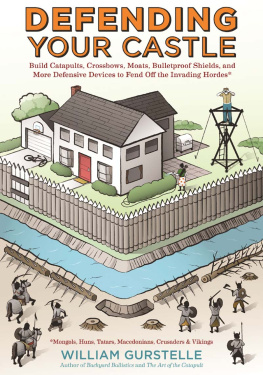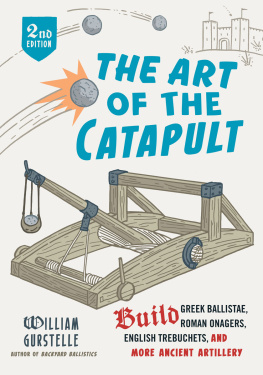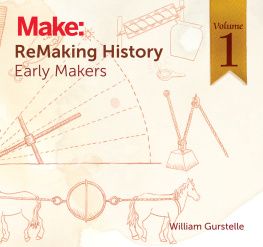Copyright 2014 by William Curatelle
All rights reserved
Published by Chicago Review Press, Incorporated
814 North Franklin Street
Chicago, Illinois 60610
ISBN 978-1-61374-682-0
The author and the publisher of this book disclaim all liability incurred in connection with the use of the information contained in this book.
Questions? Comments? Visit www.DefendingYourCastle.com
Library of Congress Cataloging-in-Publication Data
Curstelle, William.
Defending your castle : build catapults, crossbows, moats, bulletproof shields, and more defensive devices / William Curstelle.
pages cm
Includes bibliographical references and index.
ISBN 978-1-61374-682-0 (trade paper)
1. CatapultDesign and construction. 2. CrossbowsDesign and construction. 3. FortificationDesign and construction. 4. Siege warfare. I. Title. II. Title: Build catapults, crossbows, moats, bulletproof shields, and more defensive devices.
U873.G87 2014
623.441dc23
2013046712
Cover design and art: Damien Scogin
Interior design: Scott Rattray
Interior illustrations: Damien Scogin
Printed in the United States of America
5 4 3 2 1
My father, Harold, my brother, Steven, and my father-in-law,
Milton, were in the US armed forces and served during World
War II, the Vietnam War, and the Korean War, respectively.
This book is dedicated to them and to all the veterans who
have defended our castles.

Cave ne ante ullas catapultas ambules!
CONTENTS
Index
ACKNOWLEDGMENTS
I would like to express my gratitude to the people who saw me through this book; to all those who provided support, provided me a platform for talking things over, provided information and background, and offered comments, inspiration, and ideas. In particular, I thank my wonderful wife, Karen Hansen Gurstelle: creative, clearheaded, and thorough. This book could not have been written without her.
A CAST OF BAD ACTORS
H ow far would you go to protect yourself, your family, and your stuff? Most likely, your answer is something along the lines of well, as far as I have to. Its always been this way, since the first Neanderthal cave dweller barred access to his abode by pushing a large rock in front of the entrance.
There are two kinds of people in the world: those who have stuff and those who want to take other peoples stuff.
This book describes methods, machines, and mechanisms for defending your homeyour castlefrom all sorts of bad actors: city sackers, pillaging pirates, bad guys, trespassers, brigands, hajduks, thuggees, dacoits, and every other organized, semi-organized, or anarchic band of evildoers seeking to bring mayhem and destruction to peaceful, law-abiding people like you.
After reading this books title, you could be thinking that the projects and advice contained in this book are perhaps eight centuries out of date. Well, maybe they are. Certainly, the world is at least a bit more civilized now than it once was, and the threat of marauding hordes banging down your doors has lessened over time. Butand this is a big butit has not gone away. Although we are currently experiencing the longest sustained peace between the largest and most powerful countries in history, things could always go haywire, and in a hurry. If that happens, few things will be as important as knowing how to mount a powerful and well-considered defense of your home and property. Protecting your castle is now, and always has been, a vitally important skill set.
There have been assaults on homes, villages, towns, and cities since the dawn of human civilization. Perhaps the earliest recorded siege is the destruction of the walled city of Jericho by Joshua and the Israelites in about 1350 BCE. Joshuas technique included blowing trumpets and marching around the walls while holding the Ark of the Covenant. Apparently this worked, because the walls, reads the Bible, did fall, allowing the Israelites to sweep into the city. The only Jerichonian to survive was a single woman to whom Joshua owed a debt of gratitude.
Such violence was all too common in ancient times. For example, diagrams and hieroglyphics on tomb walls in Egypt recount an ancient siege of the Hittite city of Dapur by King Ramses II in the 13th century BCE . Using scaling ladders, bows and arrows, and other implements of warfare particular to the earliest known wars, the Egyptian invaders were able to breach the walls and conquer the poor Hittites, causing them to exclaim, We were crushed under your sandals and your might has penetrated our land!
Yes, but, you still may say, that was then and this is now. I have no need to provide for my own defense. Why, I can call the police, or if worse comes to worst, the army will protect me. Perhaps you are correct. But again, perhaps not. On the night of April 24, 1184 BCE , the citizens of Troy slept soundly, feeling confident that their army and leaders would protect them from the Greek adventurers who stood outside the city walls. But at night, Athenian soldiers crawled out of the Trojan Horse, a large hollow statue that the citys leaders had stupidly brought inside the city walls, unaware of what and who were sitting silently inside. The spies opened the gates to the invaders and by morning, Troy had fallen.
In every century, groups, countries, and tribes of people have invaded other groups. Such invasions have been as dependable and as constant as death and taxes. In Defending Your Castle, ideas for protecting your homestead, school, or workplace against threats of many types are provided. There are two main themes to the book. The first covers projects and concepts related to real, material threats to your well-being. The concepts, ideas, and thinking processes detailed are suitable for use in a wide range of situations that I hope you never experience.
The second theme is more imaginative and probably a bit more fun. It attempts to answer a theoretical, yet still important, question. To wit, if you were attacked by a fierce, wild horde of Mongols, Vikings, Huns, Macedonians, or similar group, how could you protect yourself? It is (to me at least and since you bought this book, probably to you as well) an interesting question. To answer it well delve into the history of these peoples and explore their tactics with an eye to staying out of trouble. This section is a combination of science, hands-on DIY technology, history, and a special type of history called counterfactualism that seeks to explore what-if scenarios of our past.

1.1 Troy
The Procession of the Trojan Horse into Troy by Giovanni Domenico Tiepolo, National Gallery, London
THE FIRST COUNTERFACTUAL DIY BOOK, EVER
One of the oldest and yet most popular tropes in fiction is that of alternative history stories. Basically, such stories are based on speculation about what the world would be like if instead of x happening, y had happened. For example, how would the world be different if the Confederacy had won at Gettysburg, if Ottomans conquered Vienna in 1683, or if the divine wind had not blown Mongol invaders away from Japans seacoast in 1281?
The earliest example of alternative history fiction I have found comes from the Roman writer Livy. His book Ab Urbe Condita (The city of Rome since it was founded) was written just after 9 BCE and is a monumental work, covering the history of Rome from its legendary founding by Romulus and Remus in 753 BCE to the death of Emperor Nero. For the most part, it is similar in form and tone to most classical Roman history works. Dense with dates and names, there are lots of accounts of the accomplishments the citys leaders and piles of impenetrable detail about heavy infantry battle tactics and cavalry charges. While history scholars may find it an interesting work, and certainly important, most readers would find it a dull slog indeed. Theres little in it thats novel or terribly gripping. That is, until one reaches the ninth book in the series. For in book 9, paragraph 17, Livy does something no one had done before. He changes history, figuratively and literally.
Next page











